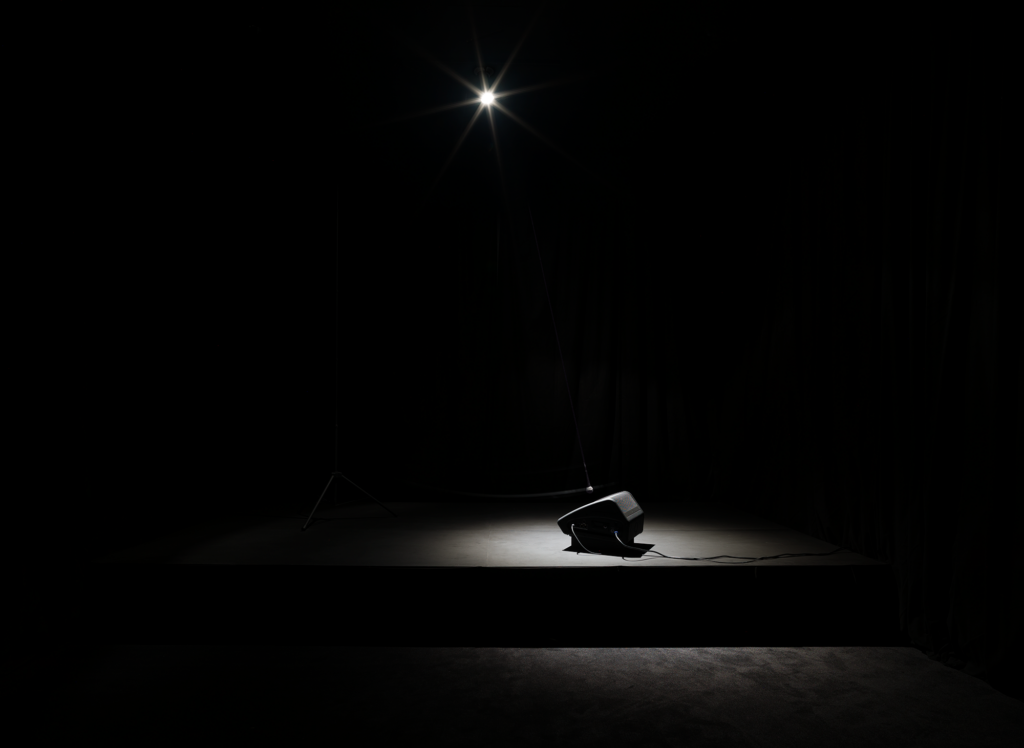Lull, 2016

Camille Norment, Lull, 2016; dynamic sound installation with pendulum microphone; dimensions variable; courtesy the Camille Norment Studio; installation view, SFMOMA, 2017; © Camille Norment; photo: Katherine Du Tiel
The music stage is defined by its sheer functionality, typically adorned only with props such as microphone stands, audio monitors, and lighting, while equipment for amplification and mixing is placed in the audience to avoid the jarring noise of acoustical interference. In Lull (2016), however, American artist Camille Norment addresses the fine line between seamless performance and interference. She upsets the standard arrangement by making the microphone a kinetic unit and letting it swing in front of a stage monitor in order to create a simple feedback mechanism. This mise-en-scène does not aim to disrupt, but rather to produce a subtle effect of ambiguity. Emanating from the monitor, which is lit by a single spotlight, a female voice sings a lullaby in endless repetition. For Norment, “the repetition of phrase and tone relays a pre-lingual message, a beckoning,” visually supported by the constant, pendulum-like swinging of the suspended microphone. As the microphone passes over the monitor, the voice temporarily distorts into feedback that resounds throughout the darkened environment. For the artist, “the intimate soothing voice, and calming situation of the lullaby and its fantasy, is repeatedly undermined by the threats of the external world.“1
Lull seeks to embody and perform a delicate relationship between sonic harmony and dissonance, underpinning it with connotations of deeply felt memories of childhood as well as cultural traditions. Norment is acutely aware of the etymology of the word lullaby. Referring to the mythological figure of Lilith, Adam’s first wife, who was cast down for refusing to submit to a subservient position, she states, “One of the accepted beliefs is that it came from the Hebrew term ‘Lilith a-bi,’ which later became ‘Lilla-be.’ It meant ‘Lilith be gone.’ This phrase was inscribed on an amulet that was placed around the child’s neck before putting it to sleep, in order to protect it from Lilith the demon who might take its life during the night.”2 Norment—whose installation Rapture, created for the 2015 Venice Biennale, referenced the history of hysteria, among other topics—here listens to the female voice.3 Far from simply offering a regressive experience, however, Lull allows visitors to observe the duality between voice and noise as a precarious border, a moment of disturbance, an instability of a living system, but gently so. There is a complex interplay between absence and presence: the microphone is alone and is clearly live—hence the feedback—and yet the singer is not onstage, even though we hear her voice. Sigmund Freud founded a large part of his psychoanalytical theory of child development on the famous “fort-da” experience, where the mother’s absence (fort, or gone) is gradually learned to be temporary as she reliably comes back and is da (there). In Norment’s installation there is both a “there” and—to borrow Gertrude Stein’s famous comment after seeking the site of her childhood home—“no there there.”
— Rudolf Frieling
Notes
- “Lull — So Ro 2016,” Camille Norment website, accessed May 3, 2017, https://www.norment.net/work/sonic-performance-ind/lull-So-Ro/. The title of the installation was abbreviated to Lull for its presentation as part of Soundtracks.
- “Camille Norment in conversation with David Toop,” April 19, 2016, Camille Norment website, accessed May 3, 2017, https://www.norment.net/work/text-ind/camille-norment-in-conversation-with-david-toop/.
- See the artist’s illuminating remarks on the relationship between hysteria, social conditions, and the voice in “The Pathology of Music: A Discussion between Camille Norment, Katya García-Antón and Antonio Cataldo,” in Rapture 03 (Oslo: Office for Contemporary Art Norway, 2015).
Watch
Camille Norment, Lull, 2016; © Camille Norment; video: courtesy the artist